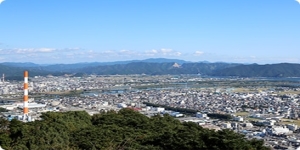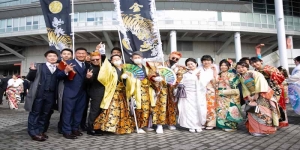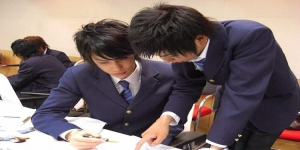Seifuku 制服 Japanese school uniforms
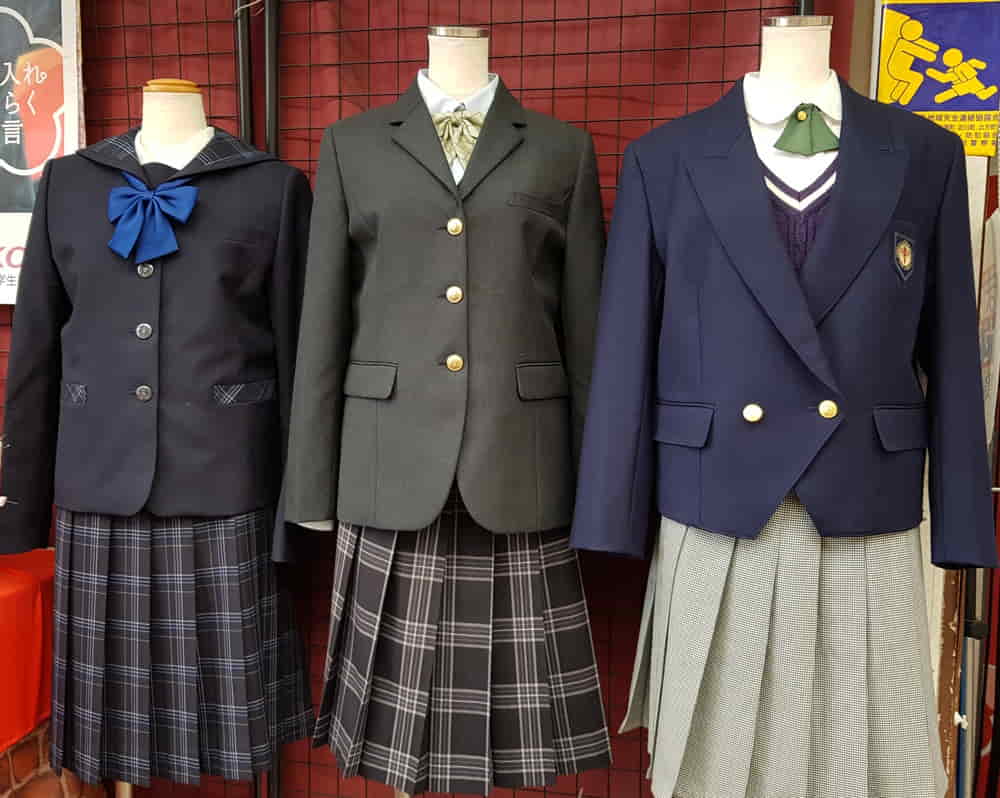
Japanese school uniforms, called seifuku 制服, are an important part of Japanese school culture. They are compulsory uniforms for primary and secondary school students and are also used in some universities. But they have gone beyond the mere scholastic aspect, becoming a pop icon and beyond.
Uniforms have a long history dating back to the Meiji period (1868-1912), when the Japanese government began to reform the country's education system to create a population that was better educated and could keep up with the innovations and changes that followed quickly. Initially, the uniforms were worn only by high schools, but over the years they have become an integral part of all schools, from elementary school to high school.
The first models that appeared were inspired by western models, with white jackets and shirts and black trousers for boys and black skirts and white shirts for girls. However, in the 1920s, the uniforms began to evolve into a unique style, with the colors, fabrics and designs specific to each school. During World War II, the Japanese government issued a law requiring schools to uniform uniforms to promote a sense of equality among students, but not only, doing so was thought to convey a sense of discipline and belonging to the community, values that are still important in Japanese culture today.
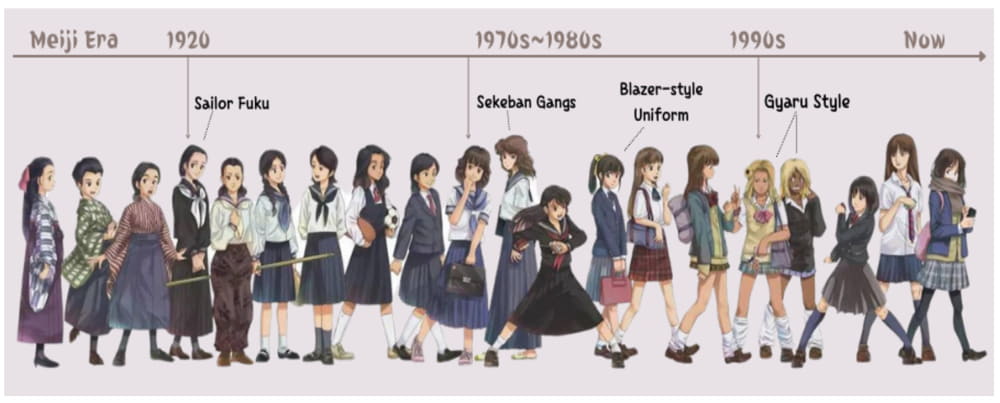
In the 1960s and 1970s, with the growing influence of Western pop culture in Japan, many schools began introducing more casual and comfortable school uniforms, such as shorts and polo shirts. However, in the 80s and 90s, the trend was to return to more traditional uniforms, to promote a sense of identity and pride in the school among students (although I wouldn't bet too much on this pride).
Today, uniforms have become an icon of Japanese culture, with many designers creating unique designs and styles for schools across the country, but not only that, one often sees original or remodeled uniforms to be used as regular clothing. However, there is also growing concern over the cost and the effect it can have on students' creativity and individuality. Some think that standardizing everyone (in some cases with very restrictive school rules, one day we will talk about it in an article) without leaving room for the uniqueness of the students does not help them in personal growth. It's a debate that pops up every now and then in Japan.
The cost of school uniforms is a very heavy item for families, of course they are bought at the beginning and changed only when one changes school or moves to a different grade (from elementary to middle school, etc.) but at that one time they are important figures for a family. Their cost can vary depending on the school and the region of the country it is located in but in general, they can be quite expensive, especially considering that students need more than one uniform for the week in addition to the bill they serve summer uniforms and winter uniforms), but not only. What the new students have to buy goes beyond just the uniform, because they also have to buy tracksuits for physical education hours, swimsuits for swimming lessons, sneakers and school bags, all of which drive costs up further.
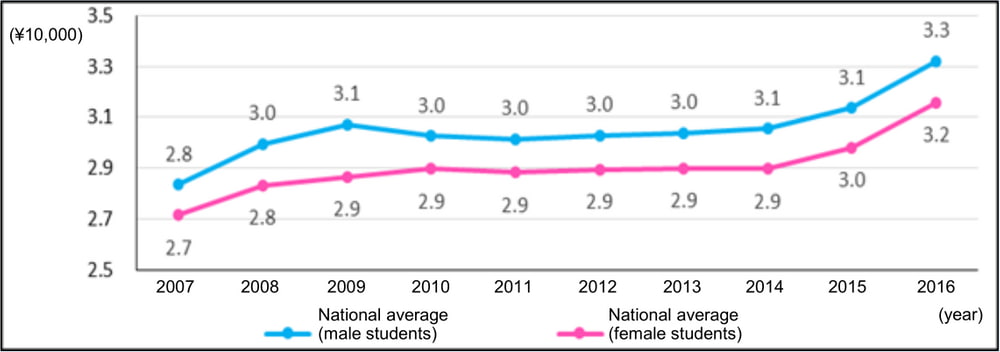
JFTC based on the "Annual Report on Retail Price Survey (Retail Price Survey (Trend Survey))," Statistics Bureau, Ministry of Internal Affairs and Communication
On average, the cost of a complete school uniform (jacket, pants/skirt, shirt, tie or pair) can vary from 20,000 to 50,000 yen, but these costs can be higher because, depending on the chosen school, the uniforms can cost much more , especially if they are made with high quality fabrics or if they are customized for the chosen school (there are uniforms for private institutes, especially the most renowned ones, which cost much more).
To alleviate costs for low-income families, there are government and private programs that offer financial assistance for the purchase of school uniforms. Additionally, some schools also offer used or loaner school uniforms to students in need.
Japanese school uniforms often feature plain colors such as dark blue, black, or gray. However, there are also different designs and patterns to choose from, such as stripes, checks or florals. Private schools have designs and accessories that serve to immediately identify the institute, a way to stand out and to make it clear immediately which school you come from. There are logos, crests, pins that complement the uniforms, a series of accessories (including bags) that allow institutions to "compete" to make themselves known.
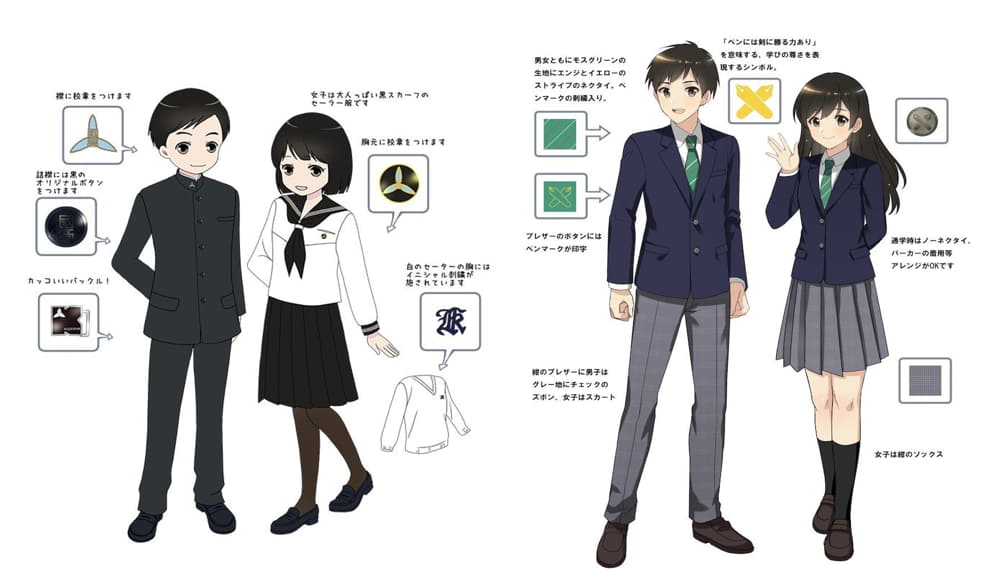
As mentioned before, Japanese school uniforms have become an icon of Japanese culture, with many schools having unique and recognizable uniforms, with people who wear them even if they are not students but only for fashion or to distinguish themselves. Here are some of the more particular uniforms:
Gakuran: The traditional school uniform for high school boys, featuring a black jacket with gold buttons and black pants. The jacket has a distinctive "V" shape on the front.
Seifuku: The traditional school uniform for high school girls, featuring a jacket with a pleated skirt. The jacket has a lapel collar and a tie.
Blazer: A more modern take on Japanese school uniforms, which replaced traditional jackets with smarter blazers. This kit was introduced in the 1980s and has more flexibility in terms of colors and styles.
Hakama: a traditional uniform for elementary and middle schools, characterized by a loose skirt that resembles trousers. This uniform was inspired by Japanese kimonos and is worn with a jacket.
Sailor Fuku: A particular school uniform for elementary and middle school girls, featuring a short skirt and a jacket with a sailor collar. This uniform was inspired by the clothes worn by Japanese sailors.
Kogal: An alternative school uniform adopted by wayward girls in the 1990s and 2000s, featuring very short skirts and fishnet stockings. This uniform has been criticized for its inappropriate sexiness, but it has had a great impact on Japanese pop culture.
Suiei-bō: A school uniform used in Japanese swimming and water sports schools, featuring long pants and a long-sleeved jacket.
These are just some of the more distinctive and recognizable Japanese school uniforms, but there are many other variations and styles that are used across the country.
What do you think about it? Many of you may know them either because they have been to Japan and seen the schoolgirls around, but I think most of us know them from anime series or TV series, dramas, where the school is often featured as a part of history and narrative.
In addition to this, uniforms have a more "intimate" impact in Japan in recent decades with the birth and growth of fetish trends linked to this particular clothing. A very particular thing also fueled by the students themselves (mostly girls) who sell their uniforms once school is over in circuits often linked to more adult entertainment.
Sources Images
devilinspired
eduzukan.jp

 English (United Kingdom)
English (United Kingdom)  Italiano (it-IT)
Italiano (it-IT) 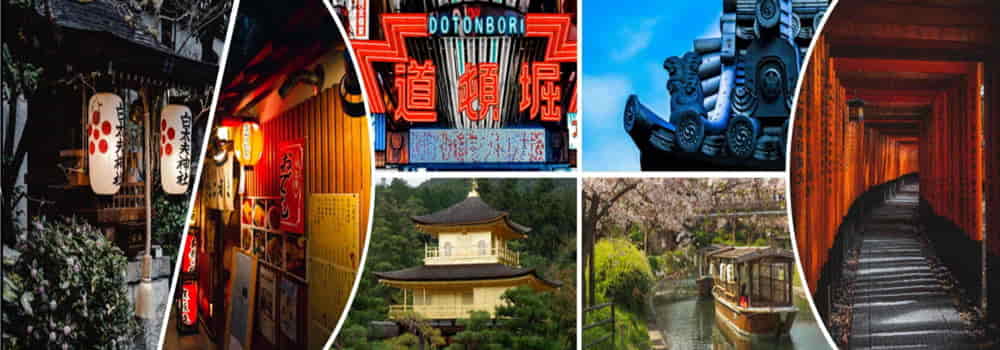


![[Review] Princess Toyotomiプリンセス トヨトミ](https://www.fukainihon.org//cache/mod_jt_contentslider/fdfb524f85518b9476158c79c8ea022f_328.png)
